|
|
|

|
 July
31, 2006: Brides, Girlfriends, and Friends July
31, 2006: Brides, Girlfriends, and Friends
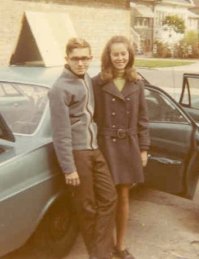 Thirty-seven
years ago tonight, I wandered into a church-basement function at
Immaculate Conception parish in the northwest corner of Chicago,
and a few hours later wandered out again, stunned at what I had
done: asked a beautiful girl out on a date, without anyone else's
intermediation. (All my previous dates had been setups.) After a
few weeks of doing unconventional things with Carol—we flew
a home-made D-stix tetrahedral kite together, looked at the stars
through my vent-pipe junkbox telescope, and attended a corn roast
at my family's summer home near Third Lake—I was stunned at
something else: She actually seemed to like me on my own merits,
nerdy and eccentric as I was. (The photo at left, from October 1969,
perfectly captures the Beauty and the Geek impression we must have
given people back in our first years together.) I had had modest
hopes of finding a girlfriend at that church basement function,
but I hit the jackpot: I found a friend instead. Thirty-seven
years ago tonight, I wandered into a church-basement function at
Immaculate Conception parish in the northwest corner of Chicago,
and a few hours later wandered out again, stunned at what I had
done: asked a beautiful girl out on a date, without anyone else's
intermediation. (All my previous dates had been setups.) After a
few weeks of doing unconventional things with Carol—we flew
a home-made D-stix tetrahedral kite together, looked at the stars
through my vent-pipe junkbox telescope, and attended a corn roast
at my family's summer home near Third Lake—I was stunned at
something else: She actually seemed to like me on my own merits,
nerdy and eccentric as I was. (The photo at left, from October 1969,
perfectly captures the Beauty and the Geek impression we must have
given people back in our first years together.) I had had modest
hopes of finding a girlfriend at that church basement function,
but I hit the jackpot: I found a friend instead.
More and more I hear guys say "my bride" instead of "my
wife." Maybe this is because "wife" has been deprecated
as a reserved word, which is one of my main gripes with our feminist
fringe. I think perhaps that the guys understand this and are reaching
a little further for a term of honor, and "bride" is certainly
that. Carol was and always will be my bride.
Alas, "bride" is not enough. I know of a number of marriages
in which bride and groom can barely stand one another. A "girlfriend"
these days usually means a woman you're sleeping with. (The irony
of "lover" as a word for a person one has sex with irrespective
of the presence of any real love has always made me grimace.) English
has many words for many odd and highly specific things—"cerate"
means "to coat with wax"—but I have yet to find the
word that combines "bride," "girlfriend," and
"friend" into a single term of honor. I suppose it's difficult
to be a spouse, lover, and friend all at the same time; more difficult,
fersure, than coating something with wax. That Carol and I have managed
it for so many years is a point of intense pride with me, and if I
can't have a word, so be it. The reality speaks for itself.
|
 July
30, 2006: Odd Notes on Chicagoland July
30, 2006: Odd Notes on Chicagoland
Carol and I are in Niles, Illinois (adjoining Chicago on the north
end) for a while, helping her mom out with a few things. Although
we both grew up here (she in the very house we're staying in) we
had forgotten a few things:
- It gets hot here—hot and smotheringly damp. I don't
know how they breathe this stuff. It was 100+ degrees here today,
with humidity you could cut with a hacksaw. I've been hiding in
the basement a lot.
- The soil is black. Very black. We took "black dirt"
for granted as kids, but everywhere else I've lived the soil has
run from brown to red. Digging in the yard was startling.
- The air raid sirens are still tested at 10:30 AM every Tuesday,
as they did when we were kids. I always thought that this was
a nationwide phenomenon, but nowhere else we've lived performs
such tests. Fort Carson sounds off a similar siren every time
anybody at the base spots a thunderhead, with a Lost In Space
robot-style voice slowly announcing "Severe...thunderstorm...warning.
Severe...thunderstorm...warning..." but tests are rare and
not at any specified time.
- We stopped for coffee at a White Hen Pantry in Crystal Lake
the other day, and they had a fresh produce rack with apples,
sweet red peppers, string beans, and sweet corn. Yet another reason
I consider White Hen the best convenience store in history. Their
coffee is spectacularly good, and they often have flavors you
don't see at other similar retailers. As best I can tell, White
Hen is a Chicago metro phenom. We've not seen them anywhere else.
Try their coffee if you haven't already.
- There is a style of two-sided poured concrete washtub in the
basement of virtually every Chicago-area house built from WWII
until 1970 or so that I've never seen anywhere else. The one we
had on Clarence Avenue in Chicago's northwest corner actually
had a little aluminum washboard embedded in the side of one of
the tubs. Having two tubs can be extremely useful, in that one
can be used to wash dogs, and the other to rinse them, especially
if the wash contains flea dip. Our dogs Hank and Smoker got this
treatment more than once, down in the basement in the house where
I grew up.
- The cicadas are going nuts this year. In the afternoon
they've been deafening, and I don't recall hearing any at all
in Colorado Springs so far. We were walking QBit down Main St.
the other day, when he happened upon an adult cicada sitting on
the sidewalk. The adults don't bite (I'm not sure they even have
mouths to bite with) but when poked they buzz startlingly. QBit
nosed it very lightly, wondering if it might be tasty, and when
the insect sounded off he jumped two feet straight up.
- Everywhere else we've lived, "family restaurants"
are dominated by monster chains like Denny's, Village Inn, and
so on. Here, there are any number of excellent one-off family
eateries, all (for some reason) owned by Greek guys. Kappy's,
Omega, and Seven Brothers are the ones we visit, but in driving
around the area I see them all over the place. The menus are unprediuctable
and a lot more varied (Kappy's sells gyros and reuben sandwiches
side by side) and I often wish some Greeks would move to Colorado
and open places like this.
|
 July
29, 2006: Artisanal Cheese July
29, 2006: Artisanal Cheese
When we were up in Wisconsin a few days ago, my cousins Rose and
Al took us around the old turf (my mother was from Wisconsin and
many of my cousins still live there) to show us, mostly, that nothing
was the way it was when we had spent time there in the late 1950s
and 1960s. We went past the old cheese factory, to which my dairy
farmer uncle had sold milk for many years. The factory is now a
quirky house and handsome in its way, though I wonder how it smells
inside on a hot afternoon. Certainly I'd prefer that it be a house
rather than a teardown to make way for a generic McMansion—but
in truth, I wish it were still a cheese factory.
Dairy farming in Wisconsin seems to be in decline. (I don't have
any hard numbers, but we didn't see many cows in fields along the
roads we traveled.) So I was pleased to read in the July 28th issue
of The Chicago Reader that Wisconsin is still ground zero
for cheese production, at 2.4 billion pounds sold last year, tops
in the country. California is right behind at 2 billion pounds,
though much of what they produce is the ugly orange "American"
cheese that I haven't willingly eaten for almost forty years.
Wisconsin apparently saw the threat from California, and has been
moving aggressively into "artisanal" cheese. (This means
cheese made by artisans,
though I didn't know "artisanal" was a word. Shades of
"liaise.") A few weeks ago Wisconsin cheeses swept the
American Cheese Society competition, held in Portland Oregon for
reasons unexplained. Blue ribbons were won by Wisconsin for things
like "best blue-mold cheese made from cow's milk" and
"best cheddar aged longer than 49 months."
I never liked cheese that much, mostly because all the cheese we
ever had at our house was that horrible American stuff, and whatever
artificially colored imitation cheese-flavored goop substitute it
was that we put on macaroni and called dinner. (I grew up poor,
and I think I've had enough mac-and-cheese and toasted cheese sandwiches
for one lifetime, thanks.) I actually learned to like cheese through
Carol, who considers it her favorite food category. I've found that
a couple of slices of a good strong Romano cheese mid-afternoon
keeps me from munching potato chips, and that after a couple of
slices, I stop. (It doesn't work that way with potato chips,
heh.)
So it's good to see that Wisconsin's designer cheese industry is
booming. Good things generally come from small producers, and there
are 1,225 licensed cheese producers in Wisconsin, almost all of
them family businesses. (That number doesn't include hobby cheesemakers,
of whom there are many.) Not all of them make money, but the artisanal
cheese field is relatively new, and I suspect that there are a lot
of other people out there like me, who would eat good cheese if
they simply knew it existed and could find it.
Alas, quirky products are often local in nature, and I don't live
anywhere near Wisconsin anymore. I have come to like quirky wines,
and have found more among Colorado wines than I can deal with; in
a sense, local wines, to compete with mass-market tank car wines
from California, almost have to be quirky. The same is likely
true of cheese, and if I can find a source for odd Wisconsin cheese
in the Springs, I will be a very happy guy.
In the meantime, you folks here in Chicago should see what interesting
things have come down I-94 from American's Dairyland, and enjoy your
privileged position as the Closest Big City to the World's Best Cheese.
|
 July
28, 2006: Combating "Government Theater" July
28, 2006: Combating "Government Theater"
Back in Chicago. And mon dieu, Chicago politics. I catch
flack when I say that politicians are liars, morons, or nasty people,
and maybe the objectors are right. Maybe it's not the people. Maybe
it's the system. The core truth is that politics as we know it today
is not about furthering the common good, but about having power
and keeping a government job. As long as politicians can look
like they're doing what the people want (or say what the people
want to hear, even if it's all lies) the people will keep electing
them. Call it "government theater." It's what we have,
and it's not doing us any good.
Maybe there's another way. Maybe democracy shouldn't be about electing
people. Maybe democracy should be about setting targets.
Imagine a system of democracy that works a little like a simulation
game, in which lawmakers may keep their offices indefinitely as
long as several key measurable societal parameters are all
kept within democratically set boundaries. The people choose the
target values via regular referenda, and the politicians are charged
with meeting the targets to keep their jobs. In other words, if
you're on the city council, you can stay on the city council as
long as budgets remain balanced, taxes do not rise, unemployment
is kept under 3%, school scores are at the national average or above,
and crime rates are at the national average or below. Lose any parameter,
and we get a special election that chooses a whole new city council
and mayor. Like Sim City without the sim. (Oh, and once you're out,
your political career is over.)
Figuring out how to set numeric targets via referenda is an interesting
problem, but not an insurmountable one.
The idea here is that politicians can say whatever they want to get
elected, but getting elected is only the beginning. Elected lawmakers
would have to produce the results that the people want, or retire.
Politicians will of course say that this is impossible, but it's unwise
to believe anything politicians say. We won't know until we try.
|
 July
27, 2006: Ghost Towns July
27, 2006: Ghost Towns

Carol, Rose, Al, and I did a little wandering before we had to
head back. We drove through several of the tiny towns near Green
Bay where we had all spent time as kids. Some, like Pulaski, seemed
to be booming. Others, like Krakow (above), the tiny hamlet just
down the road from my uncle's farm, were rapidly becoming ghost
towns. The little grocery story and the ice cream shop were gone,
though there's still a bar. Remarkably, St. Casimir's, the little
Roman Catholic church we always went to on Sunday (with the sermon
said first in Polish and then a second time in English!) is still
there and still active, set amidst beautifully maintained grounds.
By contrast, the 1928 public grade school, long shuttered, is rapidly
being absorbed by the weeds.

Interestingly, we did not see churches being turned
into bars, or organic grocery stores, or eccentric houses. The Polish-American
culture in northern Wisconsin is still strong. The cathedral in
Pulaski is enormous and full on Sundays. There's even an Old Catholic
mission church forming in Pulaski: The Polish National Catholic
Church (an Old Catholic jurisdiction with married priests and bishops)
bought an old Lutheran church and are rehabbing it.
I fought back a certain annoyance at Krakow's decline by reminding
myself that this is nothing new. Towns vanish all the time for reasons
that we may never fully understand. Towns, like farms, can consolidate,
especially with better roads and cars for anyone who wants one.
If there's more choice in Pulaski when you need to go shopping,
why stop in Krakow? I suspect that Krakow was very much the town
of very small farmers along narrow, twisting county tracks like
Gohr Road, and most of them are gone now.
I take some comfort in seeing that Krakow may be an exception.
Most of the towns we passed through in Wisconsin seemed remarkably
vibrant, with plenty of local retail and new cars in driveways.
Fewer people seem to be employed in farming, but more people are
employed in other industries, stores, and infrastructure jobs catering
to people who build houses in the far outlying towns and commute
into Green Bay.
Maybe some are even telecommiting to IT jobs in Silicon Valley, hacking
C# code between trips out to the barn to slop the hogs. For the price
of a condo in Cupertino, you can have a farm in northern Wisconsin.
And hey, if they lay you off, you still can have eggs for breakfast
every morning, and all the pork you can stand!
|
 July
26, 2006: Diversity in Small Farming July
26, 2006: Diversity in Small Farming
We went visiting today, and saw three of my cousins who are Uncle
Joey's kids, two of whom I hadn't seen since I was in high school.
Aunt Della is still alive and we visited with her as well.
It does come as a shock to see cousins as middle-aged when the
last time you saw them they were fourteen. We drove past the place
where the old farm used to be, on Gohr road near Krakow, almost
directly across from the huge Gohr family farm that was the road's
namesake. The buildings were torn down decades ago and the acreage
sold to adjoining farms. (Even the silos had been razed.) I recognized
a couple of the big trees that once held big tire swings.
(Who needs a Tilt-a-Whirl when your cousin Tony will spin the tire
with you in the middle of it?) The rest was simply gone.
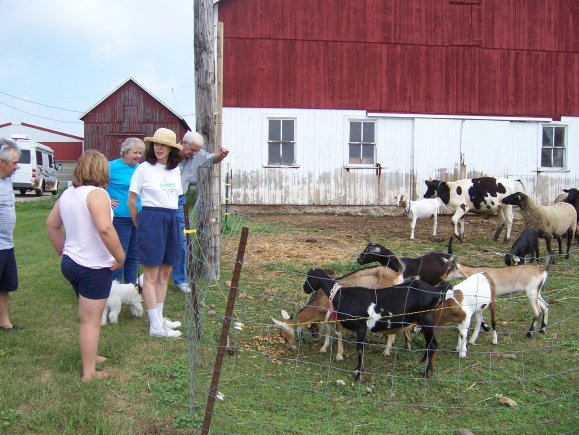
Easily the most interesting visit of the day was with my cousin
John Pryes. He's only two months younger than me, and we did a lot
of exploring in the back fields and woods on and near his family's
property when we were kids and young teens. He went back to farming
some years back after a long absense, and he works a small farm
near Pulaski with his daughter and ten-year-old granddaughter. Both
he and his daughter work day jobs; he as an IT guy at a hospital
in Appleton and she at a yacht factory in Pulaski.
 Nonetheless,
they have three small barns, a one-acre garden with everything from
sweet peas to Concord grapes, some acreage in various animal feed
crops, and an amazing diversity of animals. They have several beef
cattle, including one bull. They have two adult pigs and (currently)
eight five-week-old piglets. They have a large flock of what to
me were enormous chickens. They have several lop-eared rabbits.
They also have four or five sheep and about ten goats, along with
two dogs and an unknown number of cats. QBit was a little apprehensive,
sniffing noses through the fencing with creatures many times his
size, and one of John's cats kept trying to play with him, which
definitely took him aback. (My sister's cats are terrified of him.) Nonetheless,
they have three small barns, a one-acre garden with everything from
sweet peas to Concord grapes, some acreage in various animal feed
crops, and an amazing diversity of animals. They have several beef
cattle, including one bull. They have two adult pigs and (currently)
eight five-week-old piglets. They have a large flock of what to
me were enormous chickens. They have several lop-eared rabbits.
They also have four or five sheep and about ten goats, along with
two dogs and an unknown number of cats. QBit was a little apprehensive,
sniffing noses through the fencing with creatures many times his
size, and one of John's cats kept trying to play with him, which
definitely took him aback. (My sister's cats are terrified of him.)
The economics of a farm like this are complex. They shear the sheep
themselves and sell the wool. The breed of goats they raise are
meat animals and do not give good milk; they sell them to locals
either to augment their own herds or to slaughter. The cattle are
beef cattle, and they sell calves to other farmers. The same with
the pigs: They sell piglets to other farmers to keep genetic diversity
up, and mostly grown pigs as meat. Their chickens lay about a dozen
and a half eggs a day, which certainly keeps the family in eggs,
but isn't really enough to make much money on, though they barter
eggs for small quantities of other things they need.
And as John said with his same old wry grin, they always have as
much pork as they can stand.
Like all small farmers (and his father before him) John is an espert
Yankee mechanic, and he has two tractors in one of his barns that
have been in continuous service since WWII. He rents unneeded space
in his barns to his city friends who need a place to put their boats
or classic car projects. It's hardly the high life, but John seems
happy and healthy. He has a volleyball court next to his house and
makes time to use it. Lord knows he gets his exercise, and were it
not for the gray hair he would look ten years younger than he is.
It's not a life I could ever embrace, but I admire him for it, and
it was good to finally see him again after all these years.
|
 July
25, 2006: Barns and Back Roads July
25, 2006: Barns and Back Roads
 Wisconsin
is sacred ground for me. My mother was born here, and we visited
my dairy farmer uncle frequently when we were kids. It was the first
place I ever actually touched animals that weren't dogs, and drank
water that came out of a well. It was where I learned that peas
fresh from the pods they grew in taste way different than peas in
a can. It was where I discovered (ouch!) that cucumbers have thorns.
Coming from a claustrophobic city neighborhood as I did (the house
I grew up in was on a lot only 30 feet wide!) it just seemed like
Wisconsin went on forever. Wisconsin
is sacred ground for me. My mother was born here, and we visited
my dairy farmer uncle frequently when we were kids. It was the first
place I ever actually touched animals that weren't dogs, and drank
water that came out of a well. It was where I learned that peas
fresh from the pods they grew in taste way different than peas in
a can. It was where I discovered (ouch!) that cucumbers have thorns.
Coming from a claustrophobic city neighborhood as I did (the house
I grew up in was on a lot only 30 feet wide!) it just seemed like
Wisconsin went on forever.
Carol and I decided not to take the Interstate up to Green Bay,
or even US Highway 41, which might as well be an Interstate. Instead,
we took ordinary two-lane roads, and willingly went through small
towns instead of doing anything possible to avoid them. We didn't
steer in the direction of any tourist attractions. We just drove,
and paid attention to what went by outside the Sprinter Legend's
very big windows.
Farms, of course—and an enormous amount of green stuff, both
wild and cultivated. I've lived in dry places for almost twenty
years now, and by comparison, Wisconsin seemed like a jungle. I
expected to see a lot of cows, but in fact we saw a lot more corn
than cows. All I could think of was ethanol—or perhaps high-fructose
corn syrup. One wonders where all the milk comes from now; my guess
is California.
Dairy farming was not a big-money business even when I was a kid.
Uncle Joey had forty or fifty cows and he still had to work a second
job at a local pickle factory to make ends meet, and from what I
remember, he made about as much money selling cucumbers to local
pickle producers as he did selling milk, and he sold the farm in
the early 1970s as his children grew up and left home.
Small commodity farming as a viable business model is probably
extinct. One thing that struck me as we drove the winding roads
in rural Wisconsin was the number of concrete silos standing in
the thick of cultivated fields without any barns or other buildings
nearby. What's clearly happened is that small farms have been merged
with bigger ones, and the rickety, WW-I era buildings torn down
and sold for their weathered wood. Knocking down concrete silos
is difficult and expensive, however, so the silos are left to stand,
empty and often capless, at the edges of fields.
The farms that remain are huge, compared to my poor uncle's little
place. We would often see two or three modern barns side by side,
with bright metal silos and enormous pieces of equipment painted
John Deere green. It's big business now, and without economies of
scale, I don't think that small farms can survive.
We had a quiet dinner this evening at a restaurant along Duck Creek
near Howard with my cousin Rose and her childhood sweetheart Al.
They knew one another as young teens fifty years ago, and then left
Wisconsin to find their own lives elsewhere, complete with spouses
and kids. Now, both widowed for some years, they've returned to
Wisconsin and found one another. We toasted to steadfast love. Carol
and I know that feeling in one another; it was good to see it in
other people around us.
Tomorrow we look up some of the cousins, and cruise around the old
territory a little.
|
 July
24, 2006: Off to Wisconsin! July
24, 2006: Off to Wisconsin!

Given that we'll be here in the midwest for another
week or two, Carol and I decided to take a break and embark on a
trip-within-a-trip, to drive up to Green Bay. I have 21 first cousins
on my mother's side, of whom more than half live in Wisconsin, nearly
all within a few miles of Green Bay, and many of which I haven't
seen in more than thirty years.
So we rented another small RV and aimed its nose north this morning.
The RV is from Great West Vans, a Canadian company that specializes
in the small Class B van conversion RVs. We
rented a Class B back in June and took it to Breckenridge, and
because an RV dealer in the northwest burbs rents Class Bs, it was
a natural. The Great West Sprinter Legend is interesting because
it's basically a conversion of the Dodge Sprinter van, which was
designed by Daimler in Germany and uses a 5-cylinder (!) turbo-charged
Diesel engine from Mercedes-Benz.
It was designed as a delivery van for use in Europe, and its narrow
body probably works better on European roads. The narrow body means
that there's not a lot of elbow room inside, and although it's tall
and has plenty of headroom, the two small beds in back are probably
about what the swabbies get in the belly of an aircraft carrier.
The bathroom is basically identical to the bathroom in the Pleasureway
Class B we took to Breckenridge, with a very small shower and a
pull-out sink. We don't intend to try the shower. (I dare you to
shower well in a vehicle with a five-gallon hot water tank and two
and a half square feet of space to stand in!) The toilet is a sailboat
toilet, and although it's better than nothing, it's not a lot
better than nothing. The bathroom door kept opening on the trip
up, and I had to wedge it with the cooler to keep it from flapping
around.
 For
something this small, the Sprinter Legend has a reasonable amount
of storage space, distributed among a lot of tiny cabinets and a
decent-sized "trunk" under the beds. We had no trouble
fitting two suitcases, a storage bin, and a cooler in the vehicle,
along with my very fat briefcase and a lot of other odds and ends.
We did not rent the flat-panel TV (that was $50 extra) but there
is a TV antenna on the roof, and a built-in CD/DVD player. The refrigerator
can run on either propane or 110VAC, and did a very good job keeping
sodas, milk, cheese, bratwurst, and yogurt cold. We're keeeping
ice in the cooler for additional sodas and QBit's raw dog food that
he seems to love more than life itself. For
something this small, the Sprinter Legend has a reasonable amount
of storage space, distributed among a lot of tiny cabinets and a
decent-sized "trunk" under the beds. We had no trouble
fitting two suitcases, a storage bin, and a cooler in the vehicle,
along with my very fat briefcase and a lot of other odds and ends.
We did not rent the flat-panel TV (that was $50 extra) but there
is a TV antenna on the roof, and a built-in CD/DVD player. The refrigerator
can run on either propane or 110VAC, and did a very good job keeping
sodas, milk, cheese, bratwurst, and yogurt cold. We're keeeping
ice in the cooler for additional sodas and QBit's raw dog food that
he seems to love more than life itself.
A two-burner propane stove and a microwave oven round out the kitchen
equipment. There's a Diesel generator and an extremely powerful
interior air conditioner that got the inside of the coach so cold
that water began condensing out on the leather seats.
I doubt that Carol and I would ever buy one of these (it's just
too small to sleep comfortably in) but it was certainly fun to scoot
through small farm towns in it. The Diesel powerplant does an amazing
job on only five cylinders. The vehicle has a lot of punch, can
cruise at 80 MPH, and gets 19-22 MPG.
We stopped at a KOA campground near Fon Du Lac a few hours ago, and
because they don't have Wi-Fi, I'm not entirely sure when this will
get posted. Bear with us.
|
 July
23, 2006: Sagas and Destinies July
23, 2006: Sagas and Destinies
A couple of people wrote to ask me to clarify what I meant in my
July 20, 2006 entry, where I said that
sagas (by which I mean a background universe or situation against
which stories are written) should have destinies. My Drumlins stories
are part of something I informally call the Gaeans Saga, which includes
The Cunning Blood and its possible sequels as well.
Stories are actually about change, in a character, a situation,
or (ideally) both. So it seems to me that story backgrounds should
also change over time, just as our own history does, and ultimately
resolve issues pointed to by the stories in the saga. E. C. Tubb's
mostly forgotten Dumarest of Terra stories were a saga, in which
Dumarest searches for the lost Earth, and in each novel he finds
clues and gets a little closer. (I didn't read them all, but I think
that's a fair statement of what the saga's about.) We can hope that
the Harry Potter books will eventually say something not only about
the characters in the stories but about the relationship of magic
to humanity as a whole (muggles and all) and what the hell it all
means.
The Gaeans Saga contains a number of interesting larger issues,
a few of which are these:
- Who are the Gaeans?
- What are they up to?
- How did they arrange the universe as they did?
- And why?
- Where do the uploaded human minds go? (e.g., Jamie Eigen in
The Cunning Blood)
- What were the Thingmakers really created to do?
- What is the relationship of the Gaeans to human beings?
(There are more. I've only begun to explore the place myself.)
To come to a satisfying conclusion, all of these questions have
to be answered. And once they're answered, there's a lot less richness
to any stories you might tell within the saga. The saga has a destiny.
Some people like mystery to remain mystery, and may object to answering
questions concerning mysteries. It's like asking what the restaurants
are like in Tolkien's Uttermost West: Valinor is not about restaurants,
and is really an elf thing, closed to mankind both physically and
conceptually. That's true for mysteries that ultimately don't concern
humanity (or humanity once it's transcended its humanness) but for
ordinary human beings, mysteries were made to be solved. Stories
and sagas that pose human mysteries but do not solve them (or do
not pose them in the first place) are not as satisfying as sagas
in which lives and histories change, and in doing so provide insights
into the human condition.
That's what I meant, and that's what I intend to do in the Gaeans
Saga. It has already started. It will go somewhere. It will reach
a climax. And it will stop.
After that, well, I'll just invent another saga. That's what writers
do.
|
 July
22, 2006: Review: Monster House...in 3-D! July
22, 2006: Review: Monster House...in 3-D!
We're in Chicago for a bit, and Carol's been here now for over
a week, cleaning her mom's house with her sister. After a week of
nonstop elbow greasing, it was time for a break, and we decided
to go see Monster House. Our first issue was simply finding
a theater. With the single exception of the Pickwick in Park Ridge,
all the closest theaters we used to go to here as kids were gone—in
many cases, long gone. The elegant Gateway at Milwaukee and Lawrence
(where I remember seeing The Ten Commandments as a very small
child) is now a Polish cultural center. The Morton Grove is now
a shoe store. The theater up at Golf Mill is gone, as is the Lawrencewood
in the shopping gully my father used to call Skunk Hollow, where
I took Carol to many movies when we were teens. We had to haul east
on Touhy to some nameless multiplex to find a screen on which Monster
House was playing.
And then when we found a showing at the right time, we discovered
that the showing was in 3-D. I was nervous: Carol already had a
headache, and my experience with 3-D films was limited to two items
going on thirty five or forty years ago. One was a completely awful
Japanese trash-Tokyo monster flick, and the other was a sexploitation
thing I saw in college (about stewardesses?) of which all I remember
is instinctively ducking down in my seat as the heroine's outsized
breasts swung out over the audience. Ahh, the Seventies...
So it was with some trepidation that we bought our 3-D glasses
and took our seats. And I'll sum up this way: The movie gets three
stars, and the 3-D technology five stars. No more green and red
plastic film in cardboard goggles. The new 3-D technology is based
on polarizing filters, and while it reduces the overall brightness
of the film, the 3-D effect was absolutely dazzling.
The movie was modestly entertaining, but not in a league with Shrek,
Monsters, Inc. or A Bug's Life. There were script
problems. I kept wanting to yell at the screen: You can't compensate
for crappy writing with dazzling animation! What we really have
here is a clever half-hour short padded out to 90 minutes. The story
is simple: Two twelve-ish boys living across the street from a seriously
haunted house fail to convince the local adults that the house is
swallowing dogs, brain-damaged punker boyfriends of the babysitter,
and any toy that any unfortunate kid lands on the ravenous front
lawn. When a cute girl selling Halloween candy door-to-door to help
her exclusive prep school gets grabbed by the house, the boys rescue
her, and the three of them mount an offensive that eventually gets
things straightened out.
Alas, many of the film's best moments have nothing to do with the
haunted house. Jenny the prep school girl engages in a fiendishly
funny negotiation with the boys' babysitter, who had been tossed
out of the same prep school years earlier. The babysitter's boyfriend
Bones is as brilliant a sendup of punk pop culture as anything I've
ever seen. DJ's father is an orthodontist who is constantly schlepping
around huge models of teeth and monster toothbrushes.
I have one serious problem with the film, though telling you about
it borders on a spoiler: I do not like movies that exploit
the problems of fat people, especially fat women. The Hitchcockian
backstory involving a WWII demolitions expert and a circus fat lady
was painful to watch, and I'm sure was completely lost on the core
audience.
The climax, in which the house literally uproots itself and starts
walking down the street like a Japanese Tokyoivore, was a lot of
fun, and the whole thing took me back a little bit to my geeky 12s,
when I would oscillate between lusting after the girl down the street
and playing with telescopes and imagining vast glocal conspiracies.
None of the voices were by superstars, but all were very well done.
The animation was an interesting compromise between the creepy Polar
Express and crappy flat anime: Although the animators used motion
capture technology on young live actors, they stretched out the
bodies and exaggerated facial expressions enough so that we didn't
fall into the Uncanny Valley.
The 3-D effects were a delightful surprise. The damned house was stomping
and chomping around right in the air in front of us, and I giggled
like a kid, which proved to me that Monster House indeed achieved
its core mission. Recommended.
|
 July
21, 2006: When Books Die July
21, 2006: When Books Die
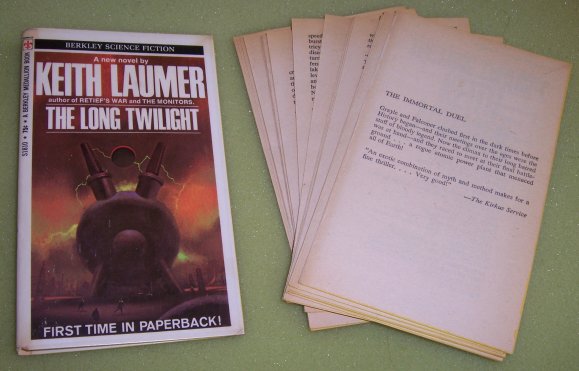
I flew in from Chicago yesterday, and spent four hours
waiting out weather delays at O'Hare before I could even get on
a plane. As always, I had a number of books in my bag, including
one that I don't think I've read in over thirty years: Keith Laumer's
1969 novel The Long Twilight. Laumer is special to me: More
than any other single writer, it was he who I imitated when I was
in high school and beginning to write SF. I discovered Laumer in
1966 with The Great Time Machine Hoax, and read him voraciously
until his work petered out in the 70s. He was a topic of much conversation
at our geek lunch table, and I studied him intensely when I was
trying to figure out how to write a good action sequence.
Although Laumer is now remembered mostly for his lighthearted Retief
stories, The Long Twilight is typical of his serious SF dramas:
Two immortal warriors from the dying interstellar empire of Ysar
are marooned on a backward planet (Earth) about our year 1000. Although
initially they are friends and colleagues, one comes to believe
(falsely) that the other has murdered his family, and so there arises
a thousand-year feud that comes to a climax only when those primitive
Earth barbarians build a wireless distribution nuclear power plant
(in the 1980s) that provides power to their technological body enhancements,
as well as their enimgmatic starship Xix, buried in the wilds of
northern Minnesota.
The Long Twilight is not Laumer's best work. It's
a novella padded out to publishable book length. I couldn't see
this when I was 17, but now, having read countless novels and written
several of my own (of which only one has seen print) I can see the
seams, the bad welds, and the glued-on bulk. There's a completely
untenable (and mostly unnecessary) subplot involving the US Army
trying to attack and turn off the power plant, which Xix is secretly
keeping running using technologies that smell perilously like occult
magick. There's a forced and completely unnecessary romantic subplot.
I guess for the hero to get the girl, there has to be a girl, though
in this case the hero seems completely uninterested in the girl
until the omniscient author forces her into Lokrien's arms on the
last page.
Doesn't matter; I recall my heart pounding as a kid while I read
the action scenes. I recall typing some of his paragraphs into my
1918 Underwood mill just to see what publishable SF would look like
on the platen in front of me. (It looked frighteningly like my own
Laumer-inspired adventures, a thrill that kept me going until I
sold my first SF yarn at age 22.) I'd really like to keep the book
on my shelf, as a lesson in how not to spin a plot, as much as for
the bad story's nostalgia value.
Alas, there's a problem: The gum that holds the pages together
and the pages to the cover dried out and cracked as soon as I opened
the book. Each time I turned a page, the page pulled loose of what
was left of the crumbling binding gum and came free in my hand.
By the time I had finished the novel, I had a stack of entirely
separate yellowed pages and the cover, which still looks great because
I covered it in Con*Tact plastic back in 1969.
I'm going to have to go looking for a hardcover copy with a sewn
binding. I'd also like to have an ebook version, but I don't know
that I want it badly enough to scan and OCR 220 fragile pulp pages
and knit them together into a PDF. I'd certainly buy an ebook if
one were available.
There is an enormous amount of money lying on the floor in the form
of third-shelf books that only a few crazies (like me) and completists
might want. Maybe the answer is a sort of compulsory licensing for
books over a certain age (25 years?) in which anyone may republish
the books as long as they pay the rightsholders (Keith Laumer is now
dead) 10% of the sale price. Big Media doesn't understand that they
would make more money by loosening the chains on older and less popular
titles, and I doubt that they ever will understand, because as I've
said here on several occasions, they're really not in it for money.
They're in it for the control. (Right Men only want money as
long as they completely control the process that generates
it.) Short of a bullet to the head, what will it take to change their
minds?
|
 July
20, 2006: Sharing a World July
20, 2006: Sharing a World
Over the past year, some writer friends and I have had some success
creating a writers' workshop here, and in several meetings we've
run about a dozen stories through the mill. Terry Blair, who writes
literary fiction of the type you'd see in The New Yorker,
made a suggestion that surprised me: That we should mount a workshop
project in which we all write a story set in a shared world. And
she wanted the world to be my Drumlins world, in which "Drumlin
Boiler" (Asimov's, April 2002) was set.
I had already been discussing this with George Ewing, and had begun
writing a backgrounder on the Drumlins universe so that he could
explore some concepts. The idea forced me to think hard about how
an imaginal world can be shared effectively. It's been tried any
number of times, and I've not been completely happy in any instance.
Harlan Ellison's Medea shared world was an utter botch. Janet
Morris' Heroes in Hell worked better as a shared world, but
the underlying concept didn't hang together very well, and a lot
of the stories quickly descended to soap opera. (A few, however,
were cracklin' good adventure.) The first few Man-Kzin Wars
stories were well-done (especially Dean Ing's), but the material
got repetitive after awhile—probably because the idea of a
war between two species is a little narrow. Perhaps the best shared
world that I've seen so far is Will Shetterly's Liavek, which
featured an all-star cast of writers and some fairly clever concepts,
though it was a sort of Arabian nights fantasy that is a tough sell
for a hard SF guy like me. All of these projects were creatures
of the 1980s, and there may be newer and better examples. I'm looking
around for good shared worlds to learn from, and suggestions are
welcome, especially if they're hard SF rather than fantasy.
I have a strategy in mind, and I figure I'll fine-tune it as we
go. Here are some notes:
- The shared background has to be worked out in enough detail
to allow a common vision of what is to take place here. I currently
have 8,000 words in the backgrounder, with more to come. As our
workshoppers ask questions about how things work on Drumland,
I've been adding more material to the backgrounder. This includes
specs of the planet, how the society there operates, movers and
shakers within that society, and even maps of towns and seacoasts.
And of course, there is the shared mystery of the Thingmakers,
and the 1.54 X 10E77 things that they can manufacture. I'm not
quite ready to release it yet, but at some point I will make the
backgrounder document freely available.
- Writers contributing to a shared world have to show their hands
early and often. Internal consistency is crucial. (This is where
the Medea world failed.) Contradictions among writers'
depiction of background elements and storylines confuse readers
and make the whole thing a headache to read. We can strive to
surprise our readers, but we can't try to surprise one another.
Writers contributing have to share details of their plots and
characters not only with me, but with all the other contributors,
so that we can resolve the inevitable collisions by consensus
and not always be tripping on one another's egos. (It may help
that none of us are famous SF writers.)
- A shared world should have a destiny. It shouldn't just be a
sitcom, or an episodic adventure. I'm going to try and guide the
creative process such that all the stories point gently toward
where the whole saga is going. And at some point, I'm going to
say, "It's done."
None of us have ever done anything like this before, and I admit that
it may not work. We're only getting started, but things are underway.
I have about a third of "Drumlin Wheel" finished, and I'm
working with Terry on her concept, which is coming along well and
is almost certainly something none of the rest of us could have done.
(I'm often delighted with what non-SF writers produce. The two Georges
are working on their concepts. I may invite a couple of other non-local
writers to consider a contribution. I'll let you know what happens
in this space.
|
 July
19, 2006: The Dog That Goes "Moo!" July
19, 2006: The Dog That Goes "Moo!"
 I
love this city for many reasons, but when I announced our move here,
a number of our more liberal friends were very unhappy. Beyond
a slightly creaky Cold War assumption that NORAD (from whose iron
door I am less than one mile) is on the Russians' first strike list,
the objection they raise has never bothered me that much: Focus
on the Family is there. I doubt that any organization is anywhere
near as abhorred on the left as FOTF, whose massive complex lies
about fourteen miles north of us, at the other extreme of the city. I
love this city for many reasons, but when I announced our move here,
a number of our more liberal friends were very unhappy. Beyond
a slightly creaky Cold War assumption that NORAD (from whose iron
door I am less than one mile) is on the Russians' first strike list,
the objection they raise has never bothered me that much: Focus
on the Family is there. I doubt that any organization is anywhere
near as abhorred on the left as FOTF, whose massive complex lies
about fourteen miles north of us, at the other extreme of the city.
I am increasingly uncomfortable with FOTF's brand of Evangelicalism
(and there's a separate story in this that I'm working up the nerve
to tell) but mostly I cordially ignore them, as I cordially ignore
most individuals and groups with whom I differ but who are unlikely
to hit me on the head and run off with my wallet. Ideology is not
my thing. On the other hand, Colorado Springs has become so unshakably
linked with the Christian Right that I have a suspicion many tech
startups are unwilling to locate here or expand here. I say that
because it comes up again and again as I chat over Skype or email
with people in tech: "Oh, you're in Colorado Springs. Christian
country. Focus is there." Everybody seems to know, and the
unspoken objection is deafening.
The tension between Focus and the culture that it loathes erupts
now and then, and we're currently in the thick of another round
here. For several weeks now, an advocacy group called Public Interest
has been funding TV commercials and banners on street lights featuring
a peculiar icon: A
dog saying "Moo!" in a speech balloon. Norman, the
dog, was born different. He doesn't bark. He moos. He didn't choose
to moo. That's just the way he is.
It's a clever, nonconfrontational,
slightly light-hearted campaign to get people talking about
why gays and lesbians are what they are. Focus on the Family, however,
is incensed. They see targets on their own foreheads, since the
Norman campaign was created for and is currently running only in
Colorado Springs. (It may be launched elsewhere in the future.)
Angry letters are going back and forth in the newspapers. Conservative
churches here are preaching against the campaign. City officials
are catching hell for accepting the campaign's banner dollars. I'm
not sure if the affair has made national news (has it?) but around
here we're starting to get a little tired of it all. Focus is now
launching a counter-campaign
starring a dog named Sherman that asks the question: When did
you last hear a dog moo? Alas, Norman is a metaphor, and not
an especially strong one. (I've never heard a dog moo, but basenjis
make a sound that is unlike any other noise I've heard out of any
other dog. Public Interest should done a little more research and
made Norman a basenji rather than a springer spaniel—but nobody
asked me.)
In conversations with people here, I get a sense that in a lot
of people's minds, Focus used to be on firmer ground. For a long
time they were mostly concerned with stabilizing shaky marriages
and opposing abortion, but the surprising influence of the gay marriage
issue in the 2004 elections caused them to shift a lot of their
energy to pushing a state consitutional amendment forbidding gay
marriage. (The amendment will be on the Colorado ballot this November.)
So what had been considered a city only moderately hostile to gays
is now considered a city extremely hostile to gay rights. Enter
Norman. And Sherman.
Alas, the discussion Norman and Sherman have fomented has been
broad but shallow. Nearly all research I have seen so far indicates
that human sexual identity is entirely genetic and unchangeable.
Focus claims that homosexuality is treatable and can be reversed.
Neither side seems willing to confront what I see ever more clearly
in the studies: That human sexual identity is a spectrum, and between
those who are clearly born gay and those who are clearly born straight
are people whose sexual identities drift across the boundaries for
reasons that are still completely obscure. Focus presents case studies
that look like they have persuaded male bisexuals to give up sexual
contacts with other males, but that's not the same thing as reversing
genuine homosexuality.
None of this bothers me directly. In a democracy, different sides
of an issue should make their cases before the public. What bothers
me is that the presence of an assertive conservative Christian organization
seems to be affecting job growth here, which I admit may be speculation,
but I see job creation happening all over the place, just not here—and
it makes me wonder. The town is beautiful, culture-rich, and inexpensive.
Gays and lesbians are not being lynched. The animus against gays runs
very deep...in a few people. Most citizens of Colorado Springs are
open-hearted and willing to let Norman—as well as Sherman and
everybody else—just be what they are and go on with their lives.
|
 July
18, 2006: We're #1! July
18, 2006: We're #1!
We. Colorado Springs. Our frothy and mostly useless daily paper
announced that Money Magazine has named Colorado Springs
as #1 on their list of best cities over 50,000 population. I haven't
been able to lay hands on the magazine itself yet, but there's a
summary here.
The primary factors were things like easy commutes (the city is
physically small and the roads generally good) clean air and water,
moderate climate, good schools, lower-than-average housing prices,
and proximity to some spectacular recreation. Interestingly, although
the local business environment is quite good compared to a lot of
places, there isn't a lot of strong economic activity here right
now, especially in the high-tech industries, except things
relating directly to military aerospace. I have a couple of friends
with a fair bit of experience in networking and programming who
just can't find jobs, and that puzzles me. It's a gorgeous place,
the living is relatively cheap for a largish city, and it's close
enough to Denver so that anything you can't get here is an hour's
drive north.
So where the hell are the non-military jobs?
I'm a little short on time here today, but I'll address some theories
tomorrow, including some discussion of a really ugly fight
going on here that most of the country isn't aware of. Stay tuned.
|
 July
17, 2006: Library Thing July
17, 2006: Library Thing
A few weeks ago I stumbled on LibraryThing,
a Web cataloging site for personal book collections. In recent months
I've been slowly scanning and entering books into a Win32 client
called Readerware (See my entry for April
13, 2006) as a disaster recovery mechanism, and LibraryThing
represents an alternative approach: Store your personal library
catalog online, and it won't burn up if your house does and your
laptop goes with it.
You can post up to 200 books with the free membership. I popped
for the $25 unlimited lifetime membership without half thinking.
I'm in the book business and it's a business expense; besides, I
need to know how this thing handles tonnage. You can find my
collection by looking for user Jeff_Duntemann.
Library Thing would be useful even if you could only see your own
collection. But it also allows you to see what other people own,
and for publishers, this can be very useful intelligence
about what the market is doing. For example, one of the most popular
authors among LibraryThing members is Neil Gaiman (American Gods,
Anansi Boys) which would not have been my guess. LibraryThing
uses the "cloud" UI mechanism, in which the point size
of items in a list is proportional to some value in the database;
in this case the number of copies of an author's books in member
libraries. (Click here
to see what I mean.) I spent a lot of time looking at the stats.
Among the books that I've entered so far, the most popular among
other LibraryThing members is Jered Diamond's Guns, Germs, and
Steel, with 1,318 copies in other member hands, and The Screwtape
Letters second, at 1,137 copies shared.
You can enter books by hand, either by entering an ISBN or Library
of Congress call number and submitting an online query, or by typing
in all the information. For older books without ISBNs, this is the
only way to go. If you already have your books cataloged somehow,
you can try their "bulk add" feature, which allows you
to hand LibraryThing a text file of some kind (typically an HTML
or CSV file exported from a local database) from which it will pick
ISBNs and perform automated lookups on up to three online library
databases. (I chose the default set, which is Amazon US, the Library
of Congress, and Amazon UK.)
The automated lookups are queued up so that they march through
Amazon and the LoC at a measured rate. If the system is popular
(as it was when I discovered it, due to a writeup in the Wall
Street Journal) it can take several days for your bulk adds
to get through the queue.
I added over a thousand books using bulk add, by submitting the
HTML export files produced by the Readerware library management
database I keep on my laptop. Of those thousand books, only 13 failed
lookup. Two were French translations of my Degunking books that
I later found on Amazon France. (Duh!) Two were remodeling books
originally published in Canada that I later found on Amazon Canada.
(Double Duh!) Seven were books that were in fact listed on the US
Amazon database, but for no clear reason Library Thing had failed
to find them. Two of the books remain unfound, even though I tried
looking for them in almost thirty online library catalogs around
the world. One was a Barnes & Noble reprint of Arthur Conan
Doyle's The Edge of the Unknown, and the other a mostly useless
book called How to Contract the Building of Your New Home.
It's still beta software, and there are some weirdnesses:
- By far its worst problem is that LibraryThing doesn't properly
list bylines on books with multiple authors. Degunking Windows
is listed in their database as by Joli Ballew only, and when I
tried to fix the author field by adding my name, the field automagically
rearranged itself to "by Jeff Ballew and Joli Duntemann."
As far along as the whole thing is, I'm amazed they haven't fixed
that one yet.
- The LibraryThing system still hangs up on me now and then, or
returns peculiar error messages, especially when I try to add
a book from search results returned by the Library of Congress.
Beta problems, I can only assume.
- LibraryThing doesn't seem to store book info in any sort of
cache, even for immensely popular books like the Harry Potter
series. Every single book instance entered into the system has
to be run past Amazon/LoC, etc. all over again. At least for books
carrying an ISBN, caching book data locally shouldn't be that
hard to do, and would make adding books to the system hugely
faster.
- LibraryThing has no way to disambiguate duplicate author names
in their own member-author program. In other words, I signed up
as a Library Thing author, with a special icon and treatment in
my profile. If there were another Jeff Duntemann who wanted to
register as an author, our books would have to be listed together,
with a manual notice that we were actually two different people.
Supposedly they'll fix this; it is, after all, still beta software.
- Some books—at least five—with a valid LoC call number
don't come up in searches of the LoC. My pre-ISBN 1966 Dell edition
of Intelligent Life in the Universe by Shklovskii and Sagan—hardly
a book of vanishing obscurity—failed every search I could
think of in every database. (Maybe the aliens kidnapped it...)
Note that this is not LibraryThing's problem; even the
Library of Congress's own site did not find 69-10184. Could there
have been that many clerical errors in logging LoC callouts?
- College textbooks seem not be in the online databases. I found
my dad's 1941 drafting textbook, but did not find either my own
1970 college drafting or Carol's 1969 high school physics textbooks.
Again, not LibraryThing's problem, but a weirdness nonetheless.
Some of my friends have asked me if it's a good idea to post the
contents of my library where everybody can see it. I thought that
one over carefully, and here is my response:
- I don't have any rare books worth breaking into the house to
steal. The most I've ever paid for a single book is $200, and
I have already destroyed it by scanning the fragile volume in
order to republish it. The binding disintegrated, and the loose
pages are now in a Baggie. Not worth much anymore, I'd guess.
I didn't even list it.
- Will the nasty old gummint decide I'm a dangerous radical by
analyzing my library? I doubt it. I have nothing by Marx, I don't
read porn, and own none of those old Loompanics classics about
picking locks and growing marijuana. I have maybe a dozen books
on politics, none of them especially strident. From ten steps
back, my collection suggests "harmless basement tinkerer
who reads SF and goes to church."
I haven't scanned all my books into Readerware yet, so what you'll
see up on Library Thing right now is perhaps half of what I own. Fiction,
humor, animals, electronics, health & medicine, travel, sociology,
literature, drama, and art have yet to go in, and there are quite
a few books still sitting in a box without having a shelf home yet.
So the experiment will go on.
|
 July
16, 2006: From the Web Stats Search Query File July
16, 2006: From the Web Stats Search Query File
sasha brabuster
Of the Boston Brabusters, I'm sure.
are stingrays the under water animal used for clothing?
Ouch!
famous goodland kansas murders
Whoops. Better move to Lawrence instead.
list of sugar defusing plant manufacturers
Be prepared; exploding jelly doughnuts are rampant.
understanding dead people
They can be just so difficult at times.
fix stale gumdrops
Waste not, want not.
turkey vacuum tube solar system
There's an SF story in there somewhere.
nud photos
Sorry. In Colorado, nuds are nocturnal, endangered, and hide
well.
darwin fish wifi emblem
I want one of those!
home depot forklift break something
Lawsuit alert!
psychopathic mouse cursors
They curse cats violently and without remorse.
some women are ingested having sex with all animals with photos
If you spot a lion with photos, run!
|
 July
14, 2006: Big Record Companies? Disposable. July
14, 2006: Big Record Companies? Disposable.
This morning's Wall Street Journal had a short article (not
available online) about major bands refusing to re-up with their
labels once their current contracts expire. Artists including Prince,
Jackson Browne, Pearl Jam and Ice Cube have basically told their
erstwhile labels that they are still willing to deal with them—but
this time on the artists' terms. This means turning down huge advances
but keeping copyright and a bigger chunk of the overall take.
The article is weak for a WSJ piece, because it doesn't
say much about how this state of affairs has come about. It's certainly
true that radio station playlists aren't the only ways to build
hits these days, as the article notes briefly and then changes the
subject. The Internet builds word of mouth in ways of which the
writer may not be aware, or may not want to admit, like P2P piracy.
It's not just Web sites anymore.
That yee-haw doofus Garth Brooks (who soiled himself in my esteem
by demanding the outlawing of used CD sales) dumped EMI, recorded
some new material at his own expense, and then cut an exclusive
deal with Wal-Mart to sell it to his core constituency. A doofus,
perhaps, but one who apparently knows who buys his CDs, and where.
Beneath all of this change lies something that the WSJ didn't
mention at all: It is getting ever cheaper and easier to create
digital music, and physical CDs are no longer the only way to deliver
it. (Stamping physical CDs can be done more cheaply and in smaller
quantities than ever before, too.) The technical expertise required
to record, mix, and cut an album has grown more common as the price
of the equipment has fallen. My sister and brother in law have an
entire recording studio in their basement and make decent money
publishing specialty music under their Dodeka
Records label.
All of this prompts one to ask: What value do gigantic record companies
add to the music industry? They used to provide the immense capital
investment it took to create, publish and promote new music, but
as the required capital has fallen, their importance has steadily
shrunk. They're not irrelevant yet (as some are already saying)
and won't be until the majority of all music sales are downloads
or direct CD sales. The only thing keeping them relevant is their
lock on the conventional B&M retail channel, and while that
will go on, the size of its piece of the overall music sales pie
will continue to fall.
Ok. Now go back through this entry and swap out "books"
for "music." Book publishing seems to be on much the same
path as music, if not so far along here in mid-2006. Linotypes,
IBM Composers, boards,
waxers,
and physical halftone screens are history, and have been since the
early 1990s. The capital investment required to create a print-ready
book image is now $2000 on the outside, and the skills required
for the job are a straight-line extension of word processing. If
you know Word, you're halfway to InDesign, PageMaker, or any other
layout app. Printing costs have plunged due to better presses, higher
productivity, and competition from overseas printers, particularly
in China.
Over time, authors who tire of watching horror scenarios like The
Incredible Shrinking Royalty Rate will choose the new path,
releasing books as ebooks and keeping older titles in print through
deals with smaller, POD-based publishers. It's already happening,
and the similarities to the music business are striking. I've asked
before and will continue to ask: What are big publishers actually
for?
Remembering, perhaps?
|
 July
13, 2006: Gorgeous, but Tasteless July
13, 2006: Gorgeous, but Tasteless
I ran up to Denver this morning, to spend a little time drooling
in the aisles at the main Rockler
woodworking store and have lunch with Larry Nelson. Larry owns a
firm called Software Planning, and sells VinBalance, a package for
managing wineries and the winemaking process. He's also been heavily
involved in the interface between Walla Walla, Washington and the
surrounding agricultural community, and spearheaded the growth of
the regional farm market in Walla Walla.
A lot of fruit is grown near Walla Walla, and Larry and I talked
about a peculiar phenomenon that I have noticed over the past 25
years or so: Supermarket fruit has been looking better and better,
while simultaneously growing almost tasteless. The best example
is strawberries: They're huge, and red, and gorgeous, and so utterly
lacking in flavor that Carol and I have basically stopped buying
them. Table grapes are also on that path. Recent grapes have been
impressively large, but very watery and lacking in flavor. (They
remind me sometimes of the squishy green paintballs that I find
in the gully behind our house after the local teenagers have been
gaming down there.)
Apples that used to truly be delicious now simply look delicious.
We don't buy the delicious variety of apples anymore because they're
mealy and tasteless. The Braeburn apples we now eat are just ok,
and we wonder how long that will continue to be the case.
What's going on here? Larry and I have a theory: Factory farming
and mass grocery retailing select products based almost solely on
how they look. One imagines that corporate megafarms don't taste
their own products. Why should they? The only people who ever get
within a hundred feet of the actual fruit are hirelings without
any authority to steer the farming process.
There's almost no feedback loop between the consumer and the grower.
The consumer's only way to register dissatisfaction is to stop buying
the fruit, which (as with all such feedback-by-refusal) doesn't
transmit much useful information to the growers. And because huge
grocery chains are almost the only access that most people have
to fruit, the end result is that people just eat less fruit.
In Walla Walla and a lot of other cities in farm country, they
address the problem by bringing farmers directly to consumers in
farm markets. Here's a
nice article on the farm market in Reno, Nevada, which made
my mouth water. Strawberries that taste like...strawberries! What
a concept! Can I have some?
We're getting into fruit harvesting season here in Colorado, and I'm
ashamed to admit that there's a farm market here in the Springs that
I've never been to. Well, that's going to change. I've been
delighted by some of the surprises I've found in locally vinted wines
made with grapes grown here in Colorado. What works for the wine may
work for the fruit as well. I'll let you know what I find.
|
 July
12, 2006: Odd Lots July
12, 2006: Odd Lots
- Conspiracy buffs may be interested in the contention that Hilary
Clinton is a closet Republican. Horrors! Hey, are we that
short of conspiracies, guys?
- People have been sending me links to bobblehead pages. Evidently,
bobblers are very big in American culture. Here's
the best collection I've seen. Want John Gotti or Jesus nodding
on your desk? You got 'em. Sigmund Freud? No problemo. Edgar Allen
Poe? Condi Rice? They're all here.
- Actually, I can't quite decide which I want for Christmas: The
Condi Rice bobblehead or the Pope
Innocent III action figure.
- I learned the other day that big band leader Fred Waring (of
Fred Waring and the Pennsylvanians) popularized
the blender appliance that later bore his name. The actual
blender concept was invented in 1922 by a guy named Stephen Poplawski,
but he didn't have a band.
- Bigelow Aerospace has finally launched its one-third
scale model of an inflatable space station on a converted
Russian ICBM. Inflatables are an obvious way to create habitable
space in space, and it's always puzzled me a little why NASA hasn't
pursued it. (And don't say that that's because "it's a good
idea" even if it's true.)
- Steampunkers may enjoy Crabfu's
Steamworks, a collection of some pretty clever steam-driven
models, including a model of a steam-driven rowboat—driven
by oars. (Thanks to George Ott for the pointer.)
- Useless knowledge: Betty Boop was originally created as a floppy-eared
anthropomorphic French poodle by the Fleischer animation gang,
back in the early 1930s when nearly all cartoon characters were
funny animals. She appeared in several cartoons as the girlfriend
of Fleischer's popular Bimbo character, who was also an anthropomorphic
dog. Betty grew so popular after a few cartoons that Fleischer
redesigned her as fully human, then was forced to drop Bimbo because
a dog with a human girlfriend suggested bestiality. By the way,
you can legally download perhaps the
weirdest and most totally surreal cartoon ever made in b/w.
This Snow White has nothing in common with Disney!
|
 July
11, 2006: The Uncanny Valley July
11, 2006: The Uncanny Valley
Back in 2001, I saw previews of a movie called Final Fantasy:
The Spirits Within, and my initial strong reaction was, Yukkh!
That's creepy! The film attempted photorealistic human characters,
and did about as well with the animation as one could do circa 2000,
but many people commented that the CGI humans were a serious turn-off.
Since then I've read of animators tweaking CGI human faces to make
them just a little less human-looking (this was done in the
Shrek movies and in The Incredibles) because when
animated humans are too close to real (without quite being fully
convincing) they inspire in people either revulsion or a kind of
nameless dread. I've known of the effect for years, but today was
the first time I knew it had a name: The uncanny valley.
Explaining the term itself may require a graph. I borrowed the
one below from Wikipedia, and if you're interested in the concept
I encourage you to read their
very detailed article on the concept.
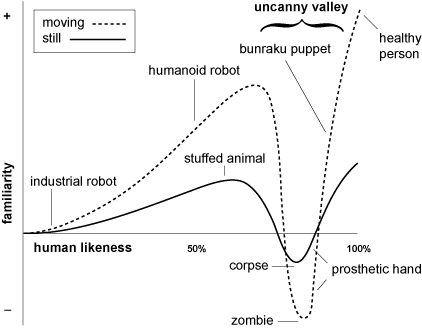
If you start with something as unlike a human being
as a robot welder, people are basically indifferent to it. (They
may correctly choose to stay out of its way, but that's a different
issue.) As you move toward things that begin to resemble the human
form, emotions engage and people respond more positively, especially
if pains are taken to avoid well-known negative images. (The Devil,
Hitler, etc.) Even odd anthropomorphic figures (think Goofy or Reddy
Kilowatt) are generally well-received if they smile and don't do
obnoxious things. At some point, when your representation of a human
being gets close enough to photoreality, acceptance goes off a cliff,
and the figure becomes creepy and disturbing. At some point further
on, if the representation becomes indistinguishable from a healthy
human face, acceptance rises again.
The Wikipedia article doesn't speculate as to why
all this should be so. The only reason I can think of for the uncanny
valley is an adaptive subconscious tendency to avoid diseased people
or corpses. We are very good at recognizing real faces, and there
comes a point along the continuum between a cartoon and a photo
where the cartoon becomes so lifelike that this ancient machinery
kicks in, and instead of a cartoon we see a face without the many
subtle indications of healthy life. The dragons of the subconscious
suggest zombies or mythic supernatural creatures instead, and we
get low-level willies.
This is significant to me because I'm tinkering with
a new novel that involves AIs being evolved within an artificial
world called the Tooniverse. The AIs are initially animated as obvious,
simple cartoons (think Cartoon Channel things like "Fairly
Odd Parents" and further on, "King of the Hill")
and as they evolve more closely to human levels of intelligence,
they are given more lifelike animated human figures. The primary
AI (named Simple Simon) understands the risk of coming to appear
a little too human. "I don't want to actually be human,"
Simon says to one of his fellow AIs. "I just want them to take
me seriously." This is hard when you resemble Homer Simpson,
but Simon doesn't want to creep people out, either.
By the way, is it just me, or should bunraku
puppets (which always seemed like high-resolution Muppets to me)
be on the opposite slope of the uncanny valley?
|
 July
9, 2006: A Different Kind of Vision July
9, 2006: A Different Kind of Vision
Kevin Anetsberger was kind enough to send me a sketch of what he
saw in the rock beside the La Garita Arch:

|
 July
8, 2006: A Lulu of a Problem July
8, 2006: A Lulu of a Problem
Boy, this is a weird one. I tried to set up an account on lulu.com,
Red Hat founder Bob Young's print-on-demand and ebook publishing
startup, which has a lot in common with my idea of an ebook gumball
machine. I can access the lulu.com Web site without any trouble
or delay. But any time I attempt a transaction that involves Lulu's
servers, the browser just grinds and grinds until it times out.
This happens with both Firefox and IE, so it isn't a browser configuration
issue; both browsers allow session cookies and Javascript. I establish
https connections with many other ecommerce sites all the time,
from monsters like Amazon to small furniture retailers. I've never
seen anything like this.
It made me nuts, and I spent an afternoon poking at the problem.
I spent an hour in a chat window with one of Lulu's support people,
and we parted company with neither of us the wiser. Then, on a hunch,
I went downstairs and logged into Lulu from one of my lab machines.
Bang! No problemo, even on my doddering old 1998 Dell Dimension.
Further checking proved that I can use Lulu normally from every
other machine in the house—except the best one, the one I use
for almost everything. Arrgh!
So the problem really is with my primary machine up here. Windows
2000 SP4, 3 GHz Pentium 4, 4 GB RAM, half a terabyte of disk. Unloading
Zone Alarm didn't change anything. Unloading Skype didn't change
anything, and there's nothing else running that fools with networking
at all.
I had hoped (and still hope) to publish my re-issue of The New
Reformation through them, but until I can figure out why my main
machine won't talk to their database servers, it's no deal. Let's
just say that I'm open to suggestions.
|
 July
7, 2006: Our Lady of the Rock Arch July
7, 2006: Our Lady of the Rock Arch
Pete Albrecht, who is nominally a Lutheran, has stolen a very Catholic
march on me by spotting the image of the Blessed Mother on the perforated
rock ridge we clambered around on this past weekend:
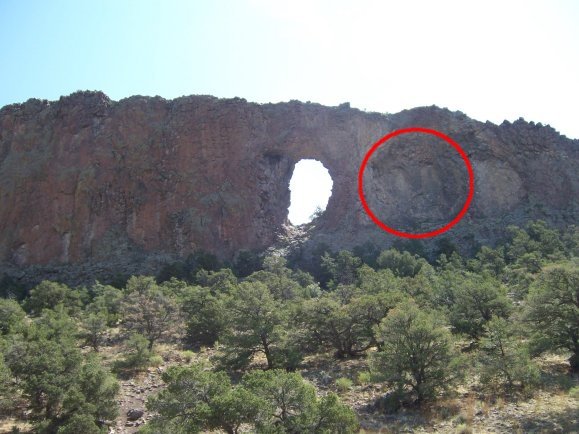
Or perhaps it was just the image of St. Pareidolia,
patron of artistic cracks in rocks and scorch marks on tortillas.
I'm ashamed to say that I was staring right at it and never saw
it. Damn.
By the way, if you want to go there and see for yourself, Bp. Sam'l
Bassett looked up the coordinates and directions and sent them to
me:
N 37 48.833' W 106
22.639' at about 8900 feet
To get there, take
US Hwy 285 to the La Garita/County Road G exit. Go West (and a
tad north) about 5.75 mi to La Garita. CRG becomes CR38A about
3/4 mile West of La Garita. Continue West about 1.5 mi to junction
of CR38A and CR41G. Go Left (South) on CR38A about 4.3 miles.
Go Right (due W) on CRE39 about 3 miles. Go Left and uphill on
unnamed trail/road about 2.5 miles You will be at about 8700 feet,
with 200 ft to climb to the arch. Behind you, as you face La Garita
Arch, is Eagle Rock. Above, beyond, and a bit to the right is
Eagle Mountain.
|
 July
6, 2006: Review: Imaginary Weapons, Part 2 July
6, 2006: Review: Imaginary Weapons, Part 2
Many years ago, I spotted a book on a remainder table somewhere
that appeared to be about...the American dog poop crisis. Really:
It was a whole book about the problems cities are having with people
not cleaning up after their dogs. I flashed on that book often as
I read Imaginary Weapons: What we have here are one or two
longish magazine articles, of the kind I enjoy reading in The
Atlantic. We do not have a whole book.
This problem is related to a second weakness, which is arguably
the more serious one: This book describes a symptom of a larger,
broader problem: Lack of adult supervision in certain areas of DoD
research. The symptom is a project that insisted on pushing ahead
with a new kind of bomb when the fundamental physics were still
in serious dispute. The Pentagon was prepared to spend hundreds
of millions—over time, probably billions—of dollars transmuting
other elements to Hafnium 178 M2 (see yesterday's entry for an explanation
of what this is) before anyone could prove that the Hafnium isomer
was "triggerable"; i.e., could be made to explode all
at once.
Author Sharon Weinberger spends a great deal of time describing
the (many) personalities involved, their eccentricities, and even
their haircuts and restaurant preferences, and never misses an opportunity
to show the men (for they were all male) at their worst, flaming
on email, calling one another fools, incompetent, conspirators,
etc. This goes on for a couple of hundred pages, and got extremely
repetitive after awhile, for she basically documents the whole saga
verbatim over a period of six years.
What do not get in the book are two critical pieces of understanding:
- What precisely is a nuclear isomer, how does it differ from
its corresponding "ground state" element, and why is
Hafnium the one everybody jumps on? There is another nuclear isomer,
of the element Tantalum, that seemed a lot less problematic to
me. (It occurs in nature, and is not radioactive.) Why was no
one chasing a Tantalum bomb? Weinberger touches on Tantalum a
time or two as though it's obvious why generals prefer Hafnium.
It is not obvious, and my suspicion is that the author
was not especially interested in nuclear physics and preferred
describing grown men throwing tantrums.
- What exactly is wrong with the Pentagon's research establishment
that allowed this little dog poop crisis to happen? Never did
I read so much about Pentagon and DARPA goings-on while understanding
so little of the underlying mechanisms. The book could have used
a chapter-length layman's overview of DoD research mechanisms,
especially how projects are approved and funded. What fragments
of a picture I got were a horrible tangled mess. This may in fact
be the problem, but it may also be the scatterbrained character
of Weinberger's writing. You can't tell strictly from the book,
and it is a matter of spectacular importance.
The book has its moments. Weinberger has a good sense for the people
she describes, and I felt that I knew them as well as I needed to.
Flashes of good, succinct writing appear from time to time, usually
amidst thirty pages of borderline padding. Perhaps without intending
to, Weinberger summarizes the entire Hafnium issue on page 147:
The problem with the
DARPA program, according to [James] Carroll, was that it focused
on just one isomer, Hafnium 178, and just one goal, low-level
triggering. Carroll described DARPA's involvement in isomer research
as an "impedence mismatch," a scientific term describing
the result of joining two systems that have different conceptual
bases. DARPA wanted a fast track, he explained, but isomer research
was still at the very basic stage. "It's a mismatch between
expectations and reality. That perhaps is the difficult part here."
Boy, is it ever.
Sharon Weinberger treats eccentric physicist Carl Collins far too
harshly, and in doing so betrays a complete misunderstanding of
the difficulties that physicists face, especially when they're intent
on pushing the envelope in major ways. As much as she (somewhat
sneeringly) quotes the foolishness that appeared under the banner
of cold fusion, she seems not to have thought deeply about the lessons
of the cold fusion debacle: The researchers may not have discovered
what they hoped they had (nearly infinite and essentially free energy)
but they may well have discovered something, and if that
something is in fact a previously unrecognized physical phenomenon,
it's worth charting out, whether it's useful or not. Similarly,
Collins may well have stumbled upon something in his experiments
with Hafnium 178 M2 and the dental X-ray machine. It clearly wasn't
what the Pentagon wanted, and almost certainly isn't any sort of
new energy source. On the other hand, if he turned up some new wrinkle
in nuclear isomer physics, that wrinkle is worth chasing, simply
because we don't yet know what other major discoveries down the
road may depend on that wrinkle. Much knowledge is accumulated in
small steps, steps that on their own may not appear to amount to
much. Real scientists know this. I don't think most journalists
do.
So in truth, I don't recommend the book. You can learn more by
googling on "hafnium 178," "nuclear isomers,"
and so on.
I want to finish up with something I spotted in the book that made
me grin. Sharon Weinberger turned up some (now terminated) Navy
programs focusing on cold fusion. When she asked the Office of Naval
Research why they had continued to support cold fusion after the
rest of the world's research community had rejected it, she got
this answer:
The Navy and the defense
of our country cannot afford to blindly accept the status quo.
When science is delegated to a narrow conventional and "normal"
view of what is possible, we severely limit out ability to make
huge technological advances. Large advances are made in two major
ways: slow, steady progress of existing knowledge, and breakthrough
concepts that challenge the scientific status quo. Both are valid.
The United States enjoys leadership in the scientific and technical
community because of the diversity of approaches we use to support
research ranging from the private sector through the varied approaches
of government funding agencies. We should all fear the day when
there is a "normal" channel by which all new scientific
ideas are evaluated for support.
In 1970, I spoke passionately of the fourth dimension to a Navy officer
who (in contrast to some of my friends and teachers) didn't think
of the geometry of higher dimensions as useless or even weird. He
probably wasn't looking for experts on the fourth dimension. I suspect
he was looking for smart kids who thought inside boxes a little bigger
than other people. Still, I have a goofy vision of myself in a Navy
officer's uniform years later, peeking into a cabinet surrounded by
peculiar machinery, and exclaiming, "My God! It's full of
stars!"
|
 July
5, 2006: Review: Imaginary Weapons, Part 1 July
5, 2006: Review: Imaginary Weapons, Part 1
 In
my senior year of high school, I was obsessed with the fourth dimension.
I spent most of my loose moments either daydreaming about my new
girlfriend Carol, or immersed in Coxeter's Regular
Polytopes. In the spring of 1970 I fielded a science fair
project called "Sections and Projections of Hypersolids"
that got me a silver medal at the public school system's city science
fair at the Museum of Science and Industry. It also got me something
else: The attention of a gray-haired admiral from the U.S. Navy,
who offered me a full ride (and spending money) at any American
university with an NROTC program, at the end of which time I would
be a Navy officer with a guaranteed job in "technology research." In
my senior year of high school, I was obsessed with the fourth dimension.
I spent most of my loose moments either daydreaming about my new
girlfriend Carol, or immersed in Coxeter's Regular
Polytopes. In the spring of 1970 I fielded a science fair
project called "Sections and Projections of Hypersolids"
that got me a silver medal at the public school system's city science
fair at the Museum of Science and Industry. It also got me something
else: The attention of a gray-haired admiral from the U.S. Navy,
who offered me a full ride (and spending money) at any American
university with an NROTC program, at the end of which time I would
be a Navy officer with a guaranteed job in "technology research."
Ulp. I was not having much luck at the scholarship game, my father
was on disability, and a job in Navy research would keep my ass
from getting shot off in Vietnam. Furthermore, the guy was persistent:
He asked for my phone number and called a couple of times, telling
me that the offer would remain open. "Son, the Navy needs minds
like yours," were his last words to me. I hate to admit it
now, but I turned him down because I wasn't ready to go away to
school, and there were no NROTC programs within commuting distance.
It's been 36 years now, and I've often wondered what the hell
the Navy was doing that required a breezy understanding of higher
dimensions.
Having just finished Sharon Weinberger's disappointing little book
Imaginary
Weapons, I think I may have a glimmer of understanding.
Imaginary Weapons is about Pentagon weapons program boondoggling,
and is focused almost completely on the peculiar pursuit of the
mythical hafnium bomb. There is a little-known backwater of nuclear
physics involving nuclear isomers, which are atoms in which the
nucleus contains excess energy stored either as spin, or as (barely)
metastable distortions in its shape. Generally, the particles in
a nucleus are lumped together in something like a sphere, but the
very occasional nucleus will be "stretched out" to the
shape of something like a football. This stored energy can be spectacularly
high: In every atom of the nuclear isomer Hafnium 178 M2 there lurks
2.5 million electron volts of potential energy. Three grams
of the stuff contains as much energy as a ton of TNT. That sort
of energy density would allow the creation of a bomb equivalent
to the Hiroshima device...in a small briefcase. Needless to say,
the very concept had military mouths watering.
The problem, of course, lay in releasing this stored energy. A
doughnut has an energy density four times that of an equivalent
mass of TNT, but no one has yet figured out how to make doughnuts
explode. Our understanding of isomer physics would suggest that
"triggering" a mass of Hafnium 178 isomer to its ground
state (thus releasing copious energy as gamma ray photons) is impossible,
but in 1998, a physicist at the University of Texas at Dallas claimed
that he had triggered Hafnium isomer atoms in a microscopic sample
by bombarding the sample with a beat-up dental X-ray machine. In
a manner eerily reminiscent of cold fusion, no one else could replicate
the results, even using the spectacular X-ray generators at major
research labs.
This didn't matter to the Pentagon, which began a several-year
program to create a bomb based on Hafnium 178 M2, even though nobody
apart from one cranky physicist could trigger isomer atoms to release
their stored energy, and the world's entire supply of Hafnium isomer
was in milligrams. (The isomer does not exist in nature and what
little we have is gathered from nuclear accelerator targets, having
been literally transmuted from other elements.) Imaginary Weapons
describes the tension between exasperated physicists who have given
the results-free research every benefit of the doubt, and the DoD
hangers-on who just know that there's a bomb in there somewhere.
It's not a pretty picture. Alas, it's also not an especially good
book, so don't buy it yet. More tomorrow.
|
 July
3, 2006: Odd Lots July
3, 2006: Odd Lots
- We took two cars on our trip to southern Colorado this past
weekend, and simply assumed we would use our cellphones to coordinate
movements. Duhh! Away from the towns there was no service. In
fact, in some of the towns there was no service. Needless to say,
there was no service on the dirt roads heading toward Garita Arch.
Just a warning to those who may decide to caravan a road trip.
Next time we'll use FRS
radios, or maybe even GMRS.
- Speaking of cellphones, Pete Albrecht sent me a link to a
cell phone that has a built-in breathalizer. If your blood
alcohol level is sensed at higher than .08%, it will warn you
not to drive—and as a bonus, will refuse to dial any of a
list of numbers that you had previously defined. (Old girlfriends?)
- A couple of people have already asked where Garita Arch is,
and if I could tell you I would. Next time we'll have a GPS receiver
with us. I even own a reasonably decent one, and didn't bring
it. I'm a disgrace to gadget freaks everywhere...
- Last night a half-mile-wide asteroid named 2004
XP14 passed about as close to Earth as the Moon does. If that
thing hit us, we would be in (literally) a world of hurt. It was
drizzling here so I didn't try to spot it, but even if the night
had been crystal-clear, identifying an 11th magnitude starlike
point among thousands of other 11th magnitude starlike points
that really are stars would have been a serious challenge, even
in my big scope. Now if we could just land a nuclear engine on
that thing and and nudge it into an Earth orbit, the stuff we
could build with it!
- I used to think that science fiction conventions were a little
specialized and peculiar. (I ceased thinking of SF conventions
as peculiar after I accidentally happened upon a Church
of the SubGenius convention back in the early 80s.) How about
a
Rocket Belt Convention? I'd want one of those if they went
a little farther on a charge of peroxide. Maybe a hafnium engine?
(Whoops, I wasn't supposed to say that. Hafnium engines are totally
imaginary. They are. Really. Don't be fooled. Nuclear isomers
cannot be harnessed. Totally impossible. Fnord!)
|
 July
2, 2006: QBit the Mountain Climber July
2, 2006: QBit the Mountain Climber
The weather turned out a little better today than yesterday, and
after checking out of the cabin this morning, we went looking for
La Garita Arch, a natural rock arch in the area. It was way
back off the paved roads, and we passed it by a couple of times
before we spotted it by noticing that the morning sun was shining
right through what looked like a mesa. The opening in the
rock was a couple hundred feet above the road, worn through an ancient
lava ridge about fifty feet thick that ran across the land for at
least a mile.

Carol had hurt her knee slightly the previous day, and didn't feel
up to the climb, so she stayed by the car with QBit while the rest
of us (including Yoji) scrambled up the rock trail to the arch.
QBit didn't care for this one bit, and was immediately straining
at the leash to follow us. I yelled down to Carol to let him go
and see what he would do, expecting him to get up the trail a little
way and then begin barking for us to return and pick him up.
Hah. QBit dashed madly up the trail at a full run, leaping up the
rocks like a mountain goat, and then sat down on a little ledge
beside me as though he did it every morning before breakfast. The
last hundred feet of the ascent was not a slam dunk, even for a
guy like me with superb balance. But when David, Terry, and Yoji
continued the climb up to the arch opening, QBit abandoned me and
followed them, bounding up the rock face with neither difficulty
nor any apparent fear.

His first action on reaching the opening was to locate a dwarf
pine and pee on it, proving to God and everyone that this was his
rock arch, and no other bichon frise had better come up here and
try and challenge him.
The view from the arch was spectacular; the photo below gives some
impression of just how big and how high the formation was. Those
are full-size trees on the desert floor below.

If QBit showed any hesitation in the adventure it was on the way
down, and being afraid that (drunk with his earlier triumph) he
would do something audacious but stupid, I ended up carrying him
down the first hundred feet of the trail from the arch, for which
he did not seem happy.
We spent some time in Monte Vista, having lunch and getting a flat
fixed, before heading home in the midst of another rainstorm. The
rain is badly needed, and I didn't mind. We had a wonderful time,
and I now know that I have the baddest bichon frise in all Colorado.
Of course, he's filthy and needs a bath (I'm sure he still has steer
crap between his toes) but he has forever broken the conventional
wisdom of fuzzy little white lap dogs who eat dainties off silver
trays.
|
 July
1, 2006: Running Into a Cattle Drive July
1, 2006: Running Into a Cattle Drive
Yesterday morning ten-ish, our friends David and Terry called to
say that they had nailed a two-bedroom cabin in southern Colorado
for a couple of days (at short notice) and...would we like to share
it with them? Uhhhh....yeah! We had assumed nothing of value would
be available anywhere for the holiday weekend, and hadn't even thought
about going anywhere. So we threw some stuff in the 4Runner, and
about 5 PM we headed south on I-25 for Foothills
Lodge in South Fork, Colorado. South Fork is about fifty miles
north of the New Mexico border, a little west of the center of Colorado.
It's on the south fork or the Rio Grande (hence the name) and is
a relatively dry area of low, pine-forested mountains.
Foothills Lodge is unusual in that they allow dogs. David and Terry
had their basenji/lab mix Yoji with them, and we brought QBit. Yoji
has known QBit since QBit was 12 weeks old, and the two of them
get on famously. (50-pound Yoji will actually let QBit shove him
away from his own food bowl, a little piece of QBit impetuousness
that would otherwise be an invitation to mayhem.)
The weather was a little gray and occasionally drippy this morning,
but South Fork lies in the midst of some beautiful country, and
we decided to get out and see a little of it. Lightning actually
chased us out of the woods a little after noon, but we had an interesting
morning poking around in the San Juan National Forest.
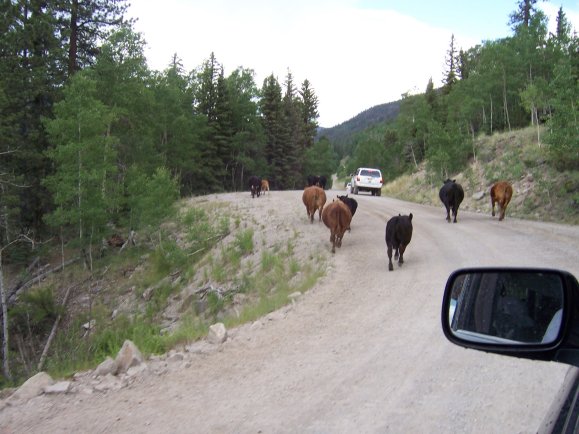
This is cattle country, as we discovered before we
even parked the car along a creek. Beef cattle were wandering around
on the road, looking dolefully at us through the car windows. We
saw 1000-pound steers nibbling scrubby grass on 60° hillsides,
and scruffy little calves drew QBit's puzzled attention.
We parked the car along the side of a small creek,
and ran the dogs around on the meadow. QBit wasted no time tramping
with all four feet through several deposits of fresh cow poop (it
was so new and loose it wasn't even formed into the canonical "pies")
and I had to dip his paws in the ice-cold creek to clean him up
before I'd let him back on the 4Runner's leather seats.

We had been wondering all morning who the cattle belonged
to, but by noon we got our answer: Six cowboys on horseback came
down a side-trail, yipping and hollering just like they do in the
movies, driving annoyed-looking cattle ahead of them. (The sound
effects seemed so peculiarly aligned with movie Westerns that I
wondered for a moment if we had wandered into a film shoot.) Other
cowboys and cattle were converging on the meadow from several directions,
with Australian shepherd dogs at their heels, yapping at the steers
and keeping them in line. Bringing up the rear were a couple of
older folks in Jeeps and pickup trucks pulling horse trailers. The
cowboys (including a couple in training who might have been as old
as 11) drove the massed cattle across the creek and up the side
of a mountain to graze (as we were told) on some meadows there.
A middle-aged woman in a pickup truck stopped for a bit and spoke
to us. Two families owned the cattle and managed them within the national
forest, which is completely legal and for which they pay the government
a fee. They still ride horses because the cattle go places where Jeeps
can't go. These will not be feedlot steers, and I suspect most of
the meat from the small herd (about 400 head) will be eaten locally.
We buy occasional steaks from local herds at Ranch Market in Colorado
Springs because they have little fat and almost zero chance of mad
cow infection, and the meat is wonderful, if pricey—hence the
"occasional." Small herds like this are probably the last
vestige of historical grass-fed cattle husbandry in Colorado, and
we felt like we were looking back in time a little. Shortly after
the cowboys and cattle vanished up the mountainside, a thunderstorm
rolled over the summit, and we decided to head back to the cabin for
some lunch.
|
|



